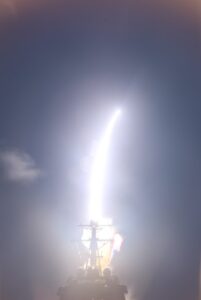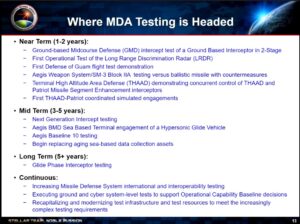HUNTSVILLE, Ala. – The acting head of the Missile Defense Agency (MDA) here Wednesday outlined the upcoming testing schedule for several systems, including the Guam Aegis defense, Long Range Discrimination Radar (LRDR) and Next Generation Interceptor (NGI).
Speaking at the annual Space and Missile Defense symposium here, Acting Director of MDA Rear Adm. Doug Williams said that in the immediate future the agency plans to test the launch of an intercontinental ballistic missile (ICBM)-range target with the
Lockheed Martin [LMT] Long Range Discrimination Radar (LRDR) installed at Clear Space Force Station, Alaska on Aug. 16.

President Biden nominated Air Force Maj. Gen. Heath Collins, Program Executive Officer for Ground-Based Weapons Systems at the Missile Defense Agency, to be the next MDA director, but Williams is serving as acting director due to Sen. Tommy Tuberville’s (R-Ala.) blanket hold on DoD nominations (Defense Daily, May 31).
Beyond being acting director, Williams has served as MDA’s director for test since June 2022.
Williams said the testing was waiting on the large Canadian summer wildfires to subside so it can now go forward.
Then, later this summer MDA plans to conduct a flight test exercise with a Ground-Based Interceptor (GBI) using a two-stage selectable feature, allowing it to hit targets in a wider set of distances from the launch site.
He said since the GBI has three rocket motor stages that use solid rocket propellant it is either burned or not, so MDA is limited in how flexible it can be.
“You don’t throttle it, you get to burn it, you have to burn it. And so that creates, I’ll say a minimum range. And so with this two stage selectable feature, it allows us to actually increase the battle space by not utilizing the ignition of the third stage rocket motor,” Williams said.
Therefore, the selectable feature will decrease the minimum range of the GBI, in effect “increasing the battlespace,” he added.
He also disclosed MDA plans to conduct the first flight test with the Aegis Weapon System deployed to Guam with a Standard Missile (SM)-3 IIA in December 2024.
Last year, MDA announced its preferred architecture to defend Guam includes mobile unit versions of the Aegis Combat System, RTX [RTX] Standard Missile (SM)-3 and SM-6 missiles, the Northrop Grumman [NOC] Integrated Air and Missile Defense Battle Command System (IBCS), the RTX Lower Tier Air and Missile Defense Sensor (LTAMDS) and Sentinel radars and maintain the THAAD system battery already deployed on Guam (Defense Daily, March 29, 2022).
The agency’s FY ‘24 budget request included $801 million to start building and continue developing the architecture for Guam defense. Within that request is $398 million for integrated missile defense including development of an AN/TPY-6 radar for long-rang midcourse discrimination, tracking and hit assessment; interfacing the Aegis Guam System with a dispersed AN/-TPY-6 radar and dispersed MK41 Vertical Launch System; and integration with a new Army missile launcher (Defense Daily, May 14).
In March, former MDA Director Vice Adm. Jon Hill said he expected the first set of interceptors, launchers, radars and command and control system to arrive on Guam in 2024 (Defense Daily, March 20).
At the time, he clarified the first increment of Guam systems will include the THAAD already deployed, four new AN/TPY-6 radars posted to give a 360-degree sensor coverage while using the same technology as the LRDR, and command and control systems.

Hill said the initial parts of the Guam defense systems will be deployed on Andersen Air Force Base since it has an existing infrastructure and runways they can use. Ultimately, though, MDA will have to go through environmental assessments to deploy systems elsewhere.
Other near-term tests include testing capabilities of the SM-3 Block IIA against a ballistic missile with countermeasures, demonstrating concurrent control of THAAD and and PAC-3 MSE interceptors, amd the first THAAD-Patriot coordinated simulated engagements.
Over the next three to five years, Williams said MDA plans to continue to “evolve the capabilities” with the Aegis sea-based terminal system engaging a hypersonic glide vehicle targets along with some Aegis Baseline 10 testing on the new Aegis Weapon System that will be deployed on the Navy’s newest Flight III Arleigh Burke-class guided-missile destroyers.